Topic: CEF
So much of our generalized understanding of the Canadian Corps in the First World War has been built up from the news stories we see around Remembrance Day each year. These views, with a focus on the worst conditions of the front lines in trench warfare, emphasizing the life of the infantry in the deepest mud, or of losses on the worst days of fighting, easily lead the recipient to forget about the many other roles filled by Canadian soldiers. Not only was there the diveristy of employment in a modern army within the four Divisions of the Canadian Corps, but there were also many soldiers employed ourtside the Corps. This excerpt, from the the Ministry for Overseas Military Forces of Canada report for 1918, describes some of the other duties and roles, each equally important for their contributions to victory and the support of the fighting man, fufilled by Canadians.
Canadian Troops Outside the Corps
From the Report of the Ministry; Overseas Military Forces of Canada; 1918
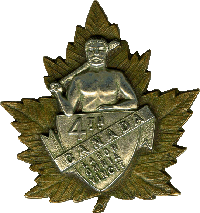
4th Battalion, Canadian Labour Corps
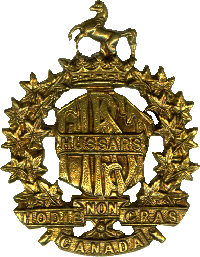
First Hussars, Canadian Cavalry Corps
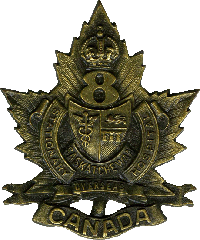
8th Stationary Hospital
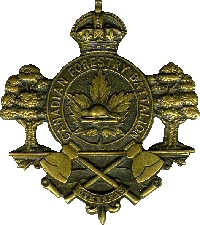
Canadian Forestry Battalion
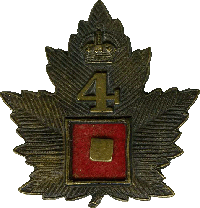
4th Battalion, Canadian Railway TRoops
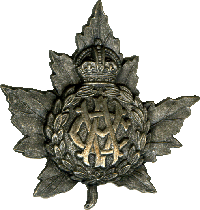
Canadian Army Veterinary Corps
Source for images: CEFSG Cap Badge Collection. See this page for other CEF badges and better quality images for reference.
In considering the achievements of the Overseas Military Forces of Canada in the field, special reference must be made to the various Formations outside the Corps, each of which rendered much valuable service in its own sphere.
In addition to the Canadian Corps, which at the time the Armistice was signed had a total strength of 110,600, there were nearly 40,000 Canadian troops, separate and distinct from the Corps serving in different capacities in the war zone throughout France and Belgium. No other British Dominion had her sons so widely distributed on the Western Front or engaged in so many diversified capacities as Canada.
This force of approximately 40,000 men was made up of railway construction experts, of lumbermen, of cavalrymen, of doctors and dentists, of engineers, butchers, bakers, and so on. Some were stationed near the North Sea, some near the Spanish border, some in Central France, and others in almost every place where there were Allied Forces. There was a large Canadian Base Camp at Etaples, for the temporary accommodation of reinforcements passing through. There were also Canadian Corps reinforcement camps in the vicinity of Aubin St. Vaast, near Montreuil, where the training was continued until the personnel were required by their respective units. The personnel at these camps were on the strength of their respective Units at the front and on the lines of communication. The functions of most of the formations that made up the 40,000 troops outside the Corps are given in various sections of this Report, but it is only just that special attention should be drawn to the work of these troops as a whole.
With the exception of the thousands of pilots and observers who were in the Royal Air Force and Independent Air Force when the fighting ended on November 11, 1918, the Canadian. troops operating in France and Belgium were, for the most part, administered by Canadian authorities, though, like the Canadian Corps, they came under Field-Marshal Sir Douglas Haig for direction in all matters connected with military operations in the field.
The largest body of Canadians on the Western Front, separate from the Canadian Corps, was the Corps of Canadian Railway Troops, a force of experts on railway construction.
For nearly two years prior to the signing of the Armistice, the Corps of Canadian Railway Troops had been responsible for the building of all the light railways in the areas occupied by the five British Armies, on a line running from the North Sea southward to the junction with the French Army. They had also been responsible for the construction of most of the new standard gauge lines radiating from the Channel Ports on the French Coast to the actual battle zones.
The Canadian Forestry Corps was the most widely-scattered body of Canadians in the Western theatre of war. There were Companies exploiting French forests near the borders of Spain, Switzerland, and Germany. Others were in Central France, at different points near the Front Line, on the Lines of Communication, and at many places in companies or smaller formations.
With the aid of attached Labour and 13 Prisoners of War Companies, the Canadian Forestry Corps supplied the greater percentage of all lumber used by the Allied Armies in France and Belgium. Only once during its career in France did the Canadian Cavalry Brigade take part as a mounted force in an engagement with the Canadian Corps. This was at Amiens on August 8. The rest of the time it fought exclusively with Imperial Forces, being attached to an Imperial Cavalry Division. It was attached to the 3rd Cavalry Division for the major portion of the time.
The Canadian Army Medical Corps had its havens of mercy widely distributed. At Boulogne there were No. 2 Canadian Stationary Hospital and No. 3 Canadian General Hospital. Nos. 1 and 7 Canadian General Hospitals were at Etaples, as was also No. 9 Canadian Stationary Hospital. No. 2 Canadian General Hospital was at Le Treport, not far from Dieppe, and Nos. 3 and 7 Canadian Stationary Hospitals were at Rouen. No. 10 Canadian Stationary Hospital was at Calais, No. 8 Canadian Stationary Hospital at Charmes, and Nos. 6 and 8 Canadian General Hospitals were in Paris. The four Canadian Casualty Clearing Stations or Hospitals, numbering 1 to 4, were moved from place to place as the military situation demanded. They were always situated within a few miles of the front line. No. 2 Canadian Casualty Clearing Station was for over two years in the British Second Army Area, being for most of that time located at Remy Siding, near Poperinghe, and almost opposite what were known as Connaught Lines, famous to Canadians in the early days of the War. It was there that several Canadian Battalions had their transport lines from time to time. The only units of the Canadian Army Medical Corps that were a part of the Canadian Corps were the Field Ambulances.
The Canadian Army Service Corps had supply units at several centres outside the Canadian Corps Area. There were four units of field bakeries and two units of field butcheries at Boulogne, while there were supply units at Etaples, Rouen, Calais, Havre, and Dieppe.
The Minister is represented at General Headquarters of the British Armies in France by what is known as the Canadian Section, and the most important functions of this Section are dealt with under a separate head.
The following list gives the chief Canadian formations that were operating outside the Canadian Corps Area in France and Belgium, with the relative strength of each, at the time the Armistice was signed:—
| Officers | Other Ranks | |
| Corps of Canadian Railway Troops | 491 | 14,390 |
| Canadian Forestry Corps | 376 | 11,375 |
| Canadian Cavalry Brigade | 141 | 2,719 |
| Canadian Army Medical Corps | 360 | 2,467 |
| Canadian Army Service Corps | 57 | 1,675 |
| Canadian Engineers Reinforcement Pool | 49 | 1,214 |
| Canadian Labour Pool | — | 1,881 |
| Canadian Base Signal Pool | 8 | 432 |
| Canadian Army Veterinary Corps | 9 | 438 |
| Canadian Army Dental Corps | 52 | 104 |
| Miscellaneous Details | 65 | 479 |
| Totals | 1,608 | 37,174 |

